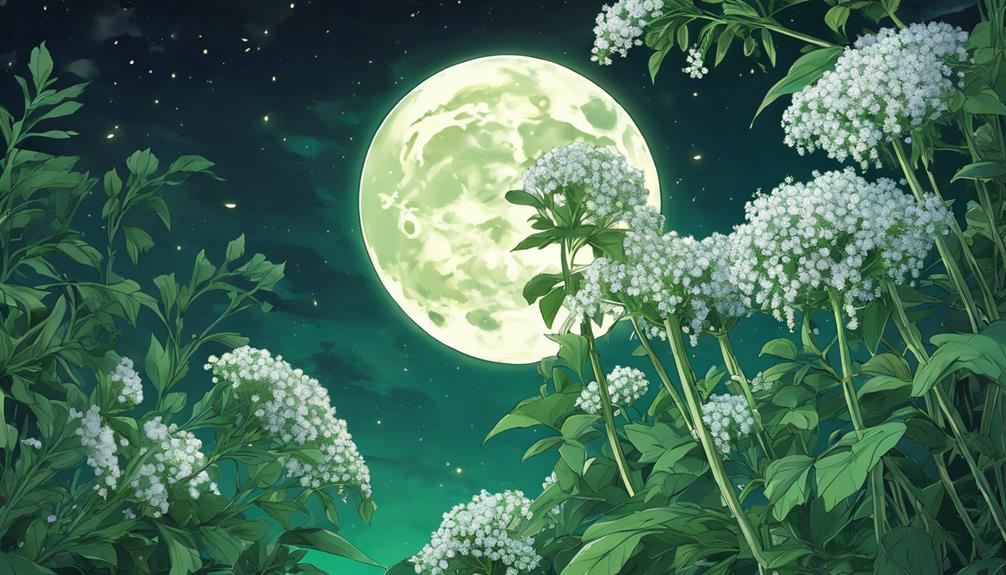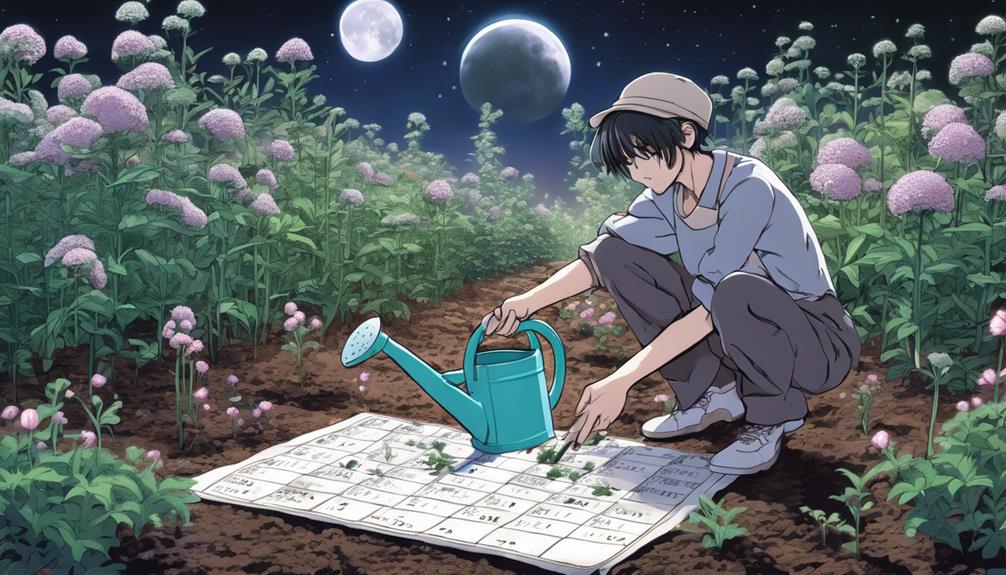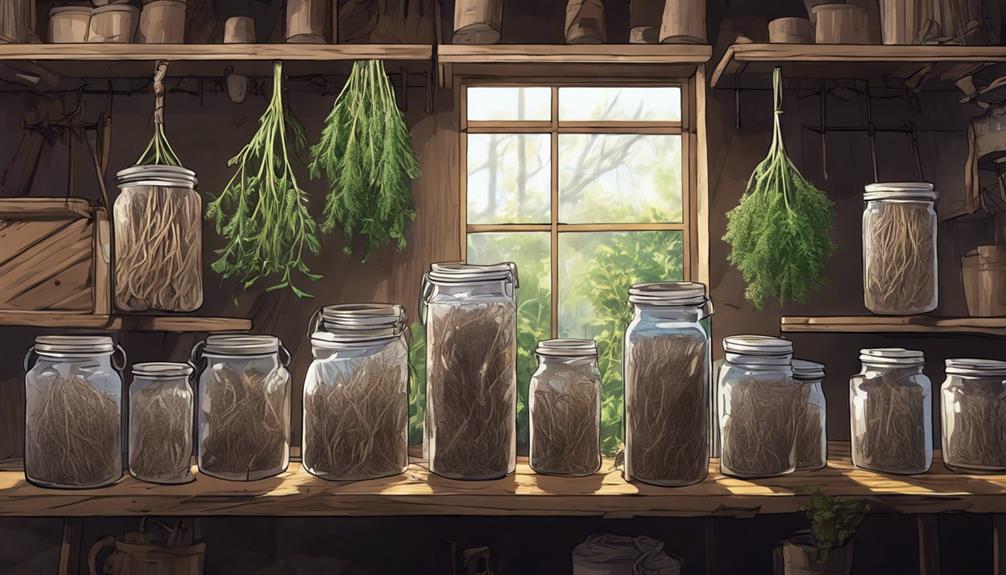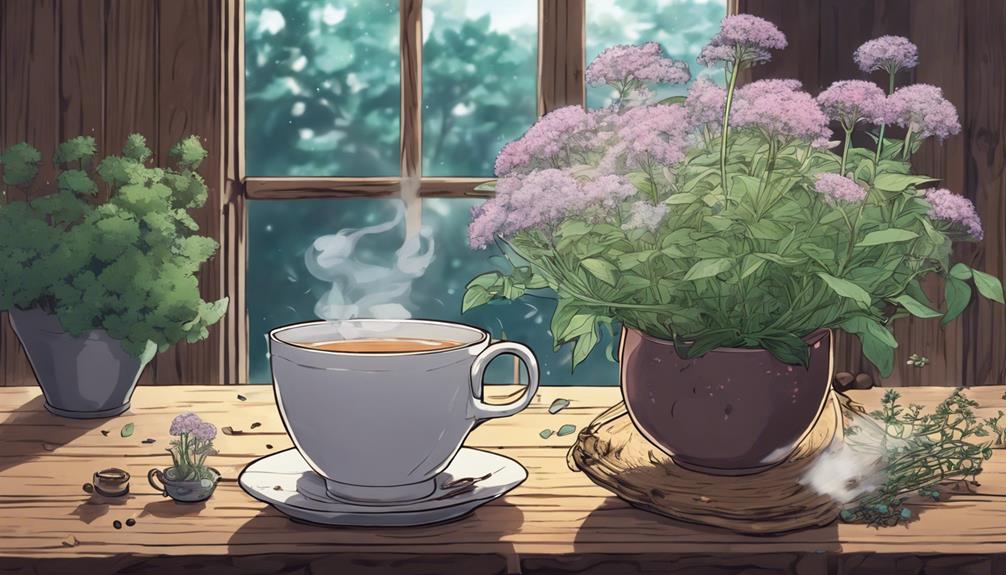You might not be aware that the distinct, somewhat pungent aroma of Valerian’s roots, often compared to well-worn socks, is actually appealing to cats and can be used as a natural sleep aid for humans.
If you’re considering ditching the sleeping pills for a more natural remedy, growing your own Valerian could be a rewarding endeavor. Not only does it offer an alternative to synthetic drugs, but it also adds a beautiful touch to your garden.
However, there’s a bit more to it than just planting and watching it grow. To unlock the full potential of this herb without compromising your health, understanding the right cultivation techniques and usage is crucial.
So lets take a look at how you can grow and harness Valerian’s natural sleep-inducing powers safely and effectively.
Valerian Basics
- Valerian (Valeriana officinalis), a herb indigenous to Europe and Asia, plays a pivotal role in natural sleep enhancement.
- Valerian enhances sleep quality by increasing GABA availability in the brain.
- Growing valerian involves spring planting or division, with autumn or winter harvest for optimal potency.
- For a natural sleep aid, steep dried valerian roots in hot water for 10-15 minutes to make tea.
- Short-term use of valerian is generally safe, but consultation with healthcare providers is recommended for personalized advice and safety.
Understanding Valerian

Valerian (Valeriana officinalis), a herb indigenous to Europe and Asia, plays a pivotal role in natural sleep enhancement due to its potent sedative properties. As you learn more about the world of herbal remedies, you’ll usually find valerian at the forefront of insomnia treatment.
This herb, with its roots, rhizomes, and stolons, has been utilized in various forms like teas, tinctures, and capsules, offering a beacon of hope for those yearning for restful nights.
Historically, valerian’s journey begins in the ancient civilizations of Greece and Rome, highlighting its enduring legacy in promoting sleep and relaxation.
What makes valerian particularly fascinating is its sedative effects, attributed to compounds such as valerenic acid. These compounds are believed to enhance the availability of the neurotransmitter GABA in the brain. GABA plays a crucial role in calming nerve activity, which is essential for achieving a state of relaxation and sleep.
Clinical studies echo the anecdotes of yesteryears, showing subjective improvements in sleep quality and reduced sleep latency among users.
This scientific validation reinforces valerian’s esteemed position in the realm of natural sleep aids, making it a cherished ally in the quest for tranquility and restorative sleep.
‘Did You Know? Valerian has also been used historically as a treatment for anxiety and stress, further showcasing its versatility in promoting mental well-being.’
Planting and Care

Valerian is a perennial flowering plant that is commonly grown for its medicinal properties, particularly its roots which have been used for centuries as a natural remedy for insomnia and anxiety.
It can grow over 5 feet tall, and as such, finds its perfect home at the back of a border, where it gains ample support. Its adaptability to various soil conditions makes it a versatile addition to your garden.
Here is a general guide on how to grow valerian:
- Choose a Suitable Location: Valerian prefers full sun to partial shade and well-draining soil. It can tolerate a wide range of soil types but prefers slightly acidic soil.
- Planting: Valerian can be grown from seeds or root cuttings. If planting seeds, sow them directly into the garden in early spring or late fall. If using root cuttings, plant them in the spring. Make sure to space the plants about 18-24 inches apart.
- Soil Preparation: Prepare the soil by loosening it to a depth of about 12 inches and adding compost or well-rotted manure to improve drainage and fertility.
- Watering: Valerian plants prefer consistently moist soil, so water them regularly, especially during dry periods. However, be careful not to overwater as this can lead to root rot.
- Fertilizing: Valerian does not require heavy fertilization. A light application of a balanced fertilizer in the spring should be sufficient.
- Maintenance: Valerian is a relatively low-maintenance plant. Remove any weeds that may compete with the plant for nutrients and water. Deadhead the flowers to encourage continuous blooming.
- Harvesting: The roots of valerian are typically harvested in the fall of the plant’s second year of growth. Dig up the roots, wash them, and dry them thoroughly before storing them for later use.
- Pests and Diseases: Valerian is relatively pest and disease-resistant. However, watch out for aphids, spider mites, and powdery mildew. Treat any infestations promptly.
- Propagation: Valerian can be propagated by dividing mature plants in the spring or fall. Simply dig up the plant, divide the roots, and replant the divisions.
- Winter Care: In colder climates, valerian plants may die back in the winter. Mulch the plants heavily to protect the roots from freezing temperatures.
Harvesting Techniques

When it comes to harvesting valerian roots, timing is key, as the late autumn or winter months yield the most potent medicinal qualities. This period ensures that the roots have accumulated maximum medicinal strength, crucial for their effectiveness as a natural sleep aid.
To further enhance this potency, you should remove the flower stalks several weeks before you begin the harvesting process. This step directs the plant’s energy back into the root, enriching its medicinal properties.
The next step involves uprooting the valerian carefully. Dig up the valerian roots from the ground using a garden fork or shovel. Shake off excess soil. Clean the roots using a soft brush or cloth to gently remove any dirt or debris from the roots. Trim off any excess root hairs or damaged parts.
Drying and Storage

The next step involves properly drying and storing the valerian roots to preserve their medicinal qualities. Once your valerian roots are thoroughly clean cut them to all to similar size to facilitate uniform drying.
You have options here: air drying or using a food dehydrator. Both methods are effective, but remember, the goal is to retain as much of the roots’ medicinal strength as possible.
To air dry valerian roots, follow these steps:
- Harvest the valerian roots: Dig up the valerian roots from the ground using a garden fork or shovel. Shake off excess soil.
- Clean the roots: Use a soft brush or cloth to gently remove any dirt or debris from the roots. Trim off any excess root hairs or damaged parts.
- Dry the roots: Place the cleaned roots in a well-ventilated area with good air circulation. You can hang them upside down from a string or lay them out on a clean surface like a wire rack or screen. Avoid direct sunlight and make sure the area is dry.
- Allow the roots to air dry: Depending on the humidity and temperature of the area, the roots may take a few weeks to dry completely. Check on them regularly to ensure they are drying properly and not developing mold or rot.
- Store the dried roots: Once the valerian roots are completely dried, store them in a cool, dark place in an airtight container. Make sure to label the container with the date and contents.
Dried valerian roots can typically keep for about one to two years if stored properly in a cool, dry place away from direct sunlight and moisture.
Over time, the potency of the roots may decrease, but they should still be usable within this timeframe. It’s always a good idea to check for any signs of mold or unusual odors before using them, and if they appear to be degraded or compromised, it’s best to replace them.
Preparing Valerian Tea

Brewing valerian tea involves steeping dried valerian roots in boiling water, a process known for its potential to enhance relaxation and improve sleep quality through its sedative properties.
This caffeine-free, natural sleep aid stands out as an alternative to traditional sleep aids, offering a method to promote relaxation and reduce the time to fall asleep without the reliance on synthetic substances.
To craft your own valerian tea, follow these steps:
- Measure the Dried Roots: Begin with about 1 to 2 teaspoons of dried valerian roots. This quantity ensures a potent enough brew to harness the sedative properties without overwhelming the senses.
- Steep in Boiling Water: Pour a cup of boiling water over the dried roots and allow them to steep for 10 to 15 minutes. This extraction time is ideal for releasing the essential compounds responsible for valerian tea’s ability to improve sleep quality.
- Adjust to Taste: Given its strong, earthy aroma and slightly bitter taste, you might want to add a sweetener or a complementary flavor, like honey or lemon, to make the tea more palatable.
Valerian tea’s unique composition not only helps you unwind but also serves as a bridge to a restful night, embodying a cherished ritual for those seeking solace in its earthy embrace.
Other Valerian Uses

Beyond its popular use in promoting restful sleep, valerian also offers significant benefits in reducing anxiety symptoms, showcasing its versatility as a natural remedy.
You’ll find valerian at the heart of many treatments aimed at enhancing relaxation and lowering stress levels. Its calming effects on the nervous system make it a potential ally against obsessive-compulsive disorder (OCD), offering a soothing touch to the often turbulent waves of anxiety.
Valerian’s sedative properties also extend its use to managing hyperactivity in both children and adults, creating a sense of calm in otherwise restless behaviors.
This same tranquility lends itself to those battling with depression, providing a natural option to ease the emotional and psychological burden.
For individuals facing the challenges of restless legs syndrome and menopausal sleep disturbances, using valerian as a sleep aid can offer improved sleep quality and a return to nighttime serenity.
There are several ways to use valerian roots besides making herbal tea.
Here are a few ideas:
- Tincture: You can make a valerian root tincture by soaking the chopped roots in alcohol for several weeks. This can be taken in small doses to help with relaxation and sleep.
- Capsules: Valerian root capsules are available in health food stores and online. These capsules contain powdered valerian root and can be taken as a supplement for relaxation and sleep support.
- Bath soak: You can create a relaxing bath soak by adding chopped valerian roots to your bath water. This can help promote relaxation and relieve stress.
- Essential oil: Valerian root essential oil can be used in aromatherapy to promote relaxation and reduce anxiety. You can diffuse the oil in a diffuser or add a few drops to a carrier oil for a relaxing massage.
- Poultice: You can make a poultice by crushing fresh valerian roots and applying them directly to the skin. This can help with muscle tension and pain relief.
Remember to consult with a healthcare provider before using valerian root in any form, especially if you have any medical conditions or are taking medications.
Safety and Precautions

While valerian offers a natural path to a good nights sleep, it’s crucial to navigate its use with informed caution to ensure safety and avoid potential risks.
- Short-Term vs. Long-Term Use: Valerian is generally safe for short-term application. However, for long-term use, be cautious as there’s a potential for dependence and withdrawal symptoms. It’s wise to consult with a healthcare provider for guidance on duration.
- Pregnancy and Breastfeeding: The safety of valerian during pregnancy and breastfeeding remains under-researched. If you’re expecting or nursing, it’s imperative to discuss valerian use with your healthcare provider to safeguard both your health and your baby’s.
- Side Effects and Interactions: Although side effects like dizziness, drowsiness, and vivid dreams may occur, especially in high doses, the most critical aspect to monitor is valerian’s interactions with alcohol, sedatives, and certain medications. Always inform your healthcare provider about your valerian use, especially if you’re taking other medications or have underlying health conditions.
An Effective Natural Sleep Aid
Valerian serves as an effective natural sleep aid, offering a traditional remedy for insomnia through its sedative properties.
Cultivating this perennial plant involves specific planting and care techniques, followed by careful harvesting, drying, and storage processes.
You can enjoy Valerian’s benefits by preparing a soothing tea or exploring its other uses. However, it’s crucial to heed safety precautions and consult a healthcare professional before incorporating Valerian into your regimen, particularly if you’re on medications or have underlying health issues.

